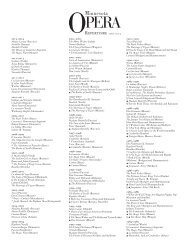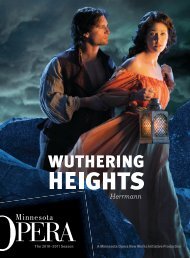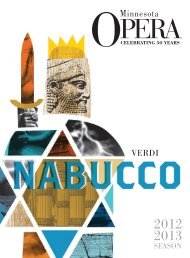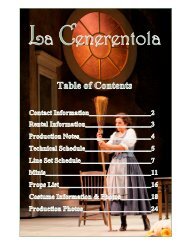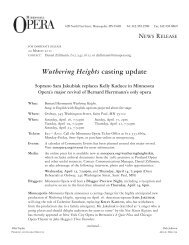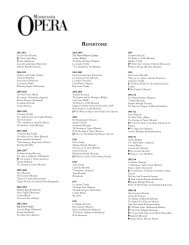You also want an ePaper? Increase the reach of your titles
YUMPU automatically turns print PDFs into web optimized ePapers that Google loves.
Early 19 th -century Italy – The Bel Canto composers<br />
gioachino rossini 1792–1868<br />
gaetano donizetti 1797–1848<br />
vincenzo bellini 1801–1835<br />
Back in Italy, opera saw the development of a distinctive style known as bel canto.<br />
Bel canto (literally “beautiful singing”) was characterized by the smooth emission of<br />
tone, beauty of timbre and elegance of phrasing. Music associated with this genre contained<br />
many trills, roulades and other embellishments that showed off the particular<br />
singer’s technique.<br />
Traditionally, a bel canto aria<br />
begins with a slow, song-like<br />
cantabile section followed by<br />
an intermediate mezzo section<br />
with a slightly quicker tempo. It ends with a dazzling cabaletta,<br />
the fastest section, where the singer shows off his or her talents.<br />
Often these were improvised upon, or replaced with “suitcase” arias<br />
of the singers’ own choosing, much to the consternation of the composer.<br />
A scene from <strong>Minnesota</strong> <strong>Opera</strong>’s<br />
2000 production of Rossini’s Semiramide<br />
Opéra, several of which show tendencies of the French grand opera style. William<br />
Tell was his last opera – Rossini retired at age 37 with 39 more years to live.<br />
gaetano donizetti and vincenzo bellini were two other Italian Bel<br />
Canto composers who premiered operas in both Paris and Italy. A tendency that<br />
began with Rossini and continued into their works was the practice of accompanied<br />
recitatives. <strong>Opera</strong> to this point had been organized in a very specific manner<br />
with more elongated “numbers”<br />
(arias, duets, ensembles) alternated<br />
with recitative (essentially dialogue<br />
set to music, intended to move the<br />
action along). In Mozart’s day, these<br />
recitative would be played by a<br />
harpsichord or fortepiano (sometimes<br />
doubled with cellos and basses)<br />
and was known as recitativo<br />
secco. As Rossini’s style progressed,<br />
the orchestra took over<br />
playing the recitatives which<br />
became known as recitativo<br />
Set model for <strong>Minnesota</strong> <strong>Opera</strong>’s<br />
2010 production of Donizetti’s Roberto Devereux<br />
Promotional material for<br />
<strong>Minnesota</strong> <strong>Opera</strong>’s<br />
2001 production of Bellini’s<br />
The Capulets and the<br />
Montagues<br />
gioachino rossini was the first and perhaps best known of the<br />
three composers associated with this style. In his early years,<br />
between 1813 and 1820, Rossini composed rapidly, producing two<br />
or three operas a year. The pace slowed after he moved to France in<br />
1824 – there he produced<br />
five works for the Paris<br />
accompagnato. The practice continued<br />
into Verdi’s day.<br />
A scene from <strong>Minnesota</strong> <strong>Opera</strong>’s<br />
2004 production of Donizetti’s Lucrezia Borgia<br />
history of opera<br />
87



